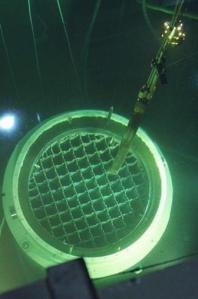Drew Barto
Senior Nuclear Engineer
 In earlier Science 101 posts, we told you about how nuclear chain reactions are used to generate electricity in reactors. In a process known as fission, uranium atoms in the fuel break apart, or disintegrate, into smaller atoms. These atoms cause other atoms to split, and so on. This “chain reaction” releases large amounts of heat and power. Another word for this process is “criticality.”
In earlier Science 101 posts, we told you about how nuclear chain reactions are used to generate electricity in reactors. In a process known as fission, uranium atoms in the fuel break apart, or disintegrate, into smaller atoms. These atoms cause other atoms to split, and so on. This “chain reaction” releases large amounts of heat and power. Another word for this process is “criticality.”
The potential for criticality is an important thing to consider about reactor fuel throughout its life. Fuel is most likely to go critical when it is fresh. It is removed from the reactor after several years (typically four to six) because it will no longer easily support a self-sustaining chain reaction. This “spent fuel” is placed into a storage pool. After cooling for some time in a pool, the fuel may be put into dry storage casks.

When fuel is removed from the reactor, we require licensees to ensure it will never again be critical. This state is referred to as “subcriticality.” Preventing an inadvertent criticality event is one safety goal of our regulations. Subcriticality is required whether the fuel is stored in a pool or a dry cask. We require it for both normal operating conditions and any accident that could occur at any time.
There are many methods that help to control criticality. The way spent fuel assemblies are positioned is an important one. How close they are to each other and the burnup of (or amount of energy extracted from) nearby assemblies all have an impact. This method of control is referred to as fuel geometry.
Certain chemicals, such as boron, can also slow down a chain reaction. Known as a “neutron absorber,” boron captures neutrons released during fission, and keeps them from striking uranium atoms. Fuel burnup is another factor. As we said above, after some time in the reactor it is harder for fuel to sustain a chain reaction. The longer the fuel is in the reactor, the less likely it is to go critical. However, high burnup fuel generates greater heat loads and radiation, which must be taken into account.
Spent fuel storage cask designs often rely on design features to make sure the fuel remains subcritical. When we review a cask design, this is one of the key elements the NRC looks at in detail.
Casks have strong “baskets” to maintain fuel geometry. They also have solid neutron absorbers, typically made of aluminum and boron, between fuel assemblies. The applications that we review must include an analysis of all the elements that contribute to criticality safety. Part of the analysis is a 3-D model that shows how the fuel will act in normal and accident conditions.

Our technical experts review this analysis to make sure the factors that could affect criticality have been identified. We check to see that the models address each of these factors in a realistic way. In cases where the models require assumptions, we make sure they are conservative. That means they result in more challenging conditions than we would actually expect. We also create our own computer models to confirm that the design meets our regulatory requirements. We will only approve a storage cask design if, in addition to meeting other safety requirements, our criticality experts are satisfied that our subcriticality safety requirements have been met.
Our reviewers look at several other technical areas in depth any time we receive an application for a spent fuel storage cask. We will talk about some of the others—materials, thermal, and shielding—in future posts.

